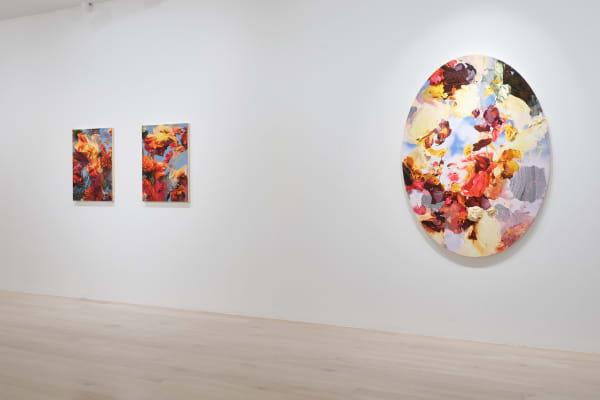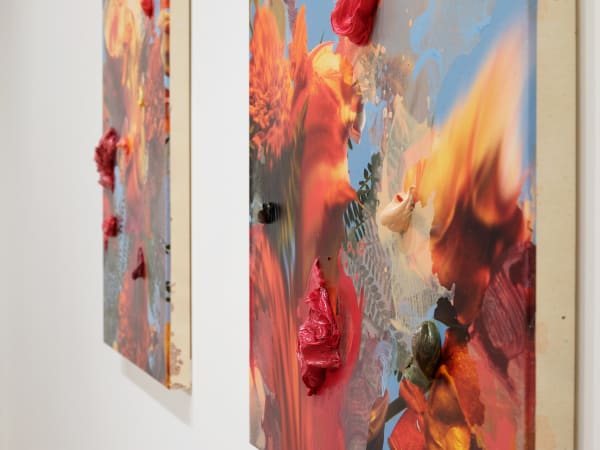Hyper-Abandonment: André Hemer
Through his combination of contemporary and traditional modes of representation, Hemer questions the ramifications of our disconnected nature of phenomenological experience. He is interested in paths where new ways of experiencing and understanding our surroundings might emerge, ways that reflect how markedly we have changed how we create and consume media in recent years, and modes of representation that embrace a sensorial understanding of time and place.
André Hemer’s paintings work with both physical and digital forms, shifting and combining modes of materiality. Using elements from the natural world as a point of departure, his work culminates in an abstracted form of contemporary landscape. Hemer has a unique way of capturing time and place through using both conventional photography and an en-plein-air flatbed scanner. Art historian Dr. Rose Vickers writes “It is September 10 at the tail end of summer, 6:50 PM, 20 degrees. Vienna’s stones are still warm from the day and André Hemer is scanning the sky.” Hemer’s natural environment gets drawn into his work, becoming a means of generating imagery, and acting as a sort of sediment of memory. Working back into the image, Hemer weaves together printed, painted and three-dimensional forms, eroding boundaries and embracing the slippages of the resulting transitions.
-
 André Hemer, Hyper-Abandonment (Los Angeles, September 22, 19:09 DST), 2022
André Hemer, Hyper-Abandonment (Los Angeles, September 22, 19:09 DST), 2022 -
 André Hemer, Hyper-Abandonment (Los Angeles, September 22, 19:10 DST), 2022
André Hemer, Hyper-Abandonment (Los Angeles, September 22, 19:10 DST), 2022 -
 André Hemer, Hyper-Abandonment (Los Angeles, September 22, 19:15 DST), 2022
André Hemer, Hyper-Abandonment (Los Angeles, September 22, 19:15 DST), 2022 -
 André Hemer, Hyper-Abandonment (Los Angeles, September 22, 19:17 DST), 2022
André Hemer, Hyper-Abandonment (Los Angeles, September 22, 19:17 DST), 2022 -
 André Hemer, Hyper-Abandonment (Los Angeles, September 22, 19:19 DST), 2022
André Hemer, Hyper-Abandonment (Los Angeles, September 22, 19:19 DST), 2022 -
 André Hemer, Hyper-Abandonment (Los Angeles, September 22, 19:23 CEST), 2022
André Hemer, Hyper-Abandonment (Los Angeles, September 22, 19:23 CEST), 2022 -
 André Hemer, Hyper-Abandonment (Los Angeles, September 24, 18:20 DST), 2022
André Hemer, Hyper-Abandonment (Los Angeles, September 24, 18:20 DST), 2022 -
 André Hemer, Hyper-Abandonment (Los Angeles, September 24, 18:25 DST), 2022
André Hemer, Hyper-Abandonment (Los Angeles, September 24, 18:25 DST), 2022 -
 André Hemer, Hyper-Abandonment (Los Angeles, September 24, 18:27 DST), 2022
André Hemer, Hyper-Abandonment (Los Angeles, September 24, 18:27 DST), 2022 -
 André Hemer, Hyper-Abandonment (Los Angeles, September 24, 18:28 DST), 2022
André Hemer, Hyper-Abandonment (Los Angeles, September 24, 18:28 DST), 2022 -
 André Hemer, Hyper-Abandonment (Los Angeles, September 24, 18:29 DST), 2022
André Hemer, Hyper-Abandonment (Los Angeles, September 24, 18:29 DST), 2022 -
 André Hemer, Hyper-Abandonment (Sicily, April 17, 14:39 CEST), 2022
André Hemer, Hyper-Abandonment (Sicily, April 17, 14:39 CEST), 2022 -
 André Hemer, Hyper-Abandonment (Sicily, September 12, 18:10 CEST), 2022
André Hemer, Hyper-Abandonment (Sicily, September 12, 18:10 CEST), 2022
André Hemer’s paintings work with both physical and digital forms, shifting and combining modes of materiality. Using elements from the natural world as a point of departure, his work culminates in an abstracted form of contemporary landscape. Hemer has a unique way of capturing time and place through using both conventional photography and an en-plein-air flatbed scanner. Art historian Dr. Rose Vickers writes “It is September 10 at the tail end of summer, 6:50 PM, 20 degrees. Vienna’s stones are still warm from the day and André Hemer is scanning the sky.” Hemer’s natural environment gets drawn into his work, becoming a means of generating imagery, and acting as a sort of sediment of memory. Working back into the image, Hemer weaves together printed, painted and three-dimensional forms, eroding boundaries and embracing the slippages of the resulting transitions.
In his most recent body of work Hemer draws from an artist residency in Sicily (2022) and from time spent in Los Angeles, locations that are each known for having particular light phenomena. In Sicily, the site of the SARP Foundation Residency dates to 1649 at the foothills of Mount Etna. The surrounding, historic gardens feature in this body of work; warm, light and sensual, the conditions of the European atmosphere show through, be it the intensity of this summer’s heatwave or the backdrop of the smoking Mt Etna. In these works we look upwards, through Hemer’s combined modes of representation, towards the sky. Pictorially, this technique refers to frescos, in particular from the Baroque period (c.1600-1750s), which utilized grandeur, detail, movement and colour to achieve a sense of awe.
This reading is reinforced by two works in particular, Hyper-Abandonment (Sicily, April 17, 1439 CEST) and Hyper-Abandonment (Los Angeles, September 24, 1827 DST), where the form of the canvas reflects an oval, or portal, such as one might find on the ceiling of a chapel.
Similarly, the work that originates from Los Angeles has a freshness and intensity of colour, a boldness that relates to the tradition of representation of natural aura. Light plays a central role in the work across both locations, combining particulars of time, day and atmospheric conditions with a contemporary experience of back-lit digital screens and capturing systems—of other portals. Through his combination of contemporary and traditional modes of representation, Hemer questions the ramifications of our disconnected nature of phenomenological experience. He is interested in paths where new ways of experiencing and understanding our surroundings might emerge, ways that reflect how markedly we have changed how we create and consume media in recent years, and modes of representation that embrace a sensorial understanding of time and place. London-based writer Issey Scott asks “Why must we know why we are drawn to any particular artwork? Why can we not submit to the sumptuousness, the sensuality, the colours that are certainly familiar but feel refreshed and re-energised? What happens when we adopt a hyper-abandonment of how we expect to feel about an artwork, and fully embrace the senses, and indeed the moment?”.
The sole video work in the exhibition Sky Sculpture (Sicily July 12, 20:09 CEST) gives an extra dimension to the sense of composite landscape that Hemer constructs. We hear birds chirping as the sky shifts slowly above. There is an uncanny translation of form and material in the spinning objects that are suspended in the foreground. Some are recognizable—painted forms apparent in other paintings in the series, and flowers scanned in 3D—yet they have a very different sense of physicality in this space. They intersect and move in an infinite loop. There is an act of transference or translation as the objects collapse and re-form, forever virtually suspended, despite their physical origins. The audio track plays an important role in the installation as a whole, becoming a unifying component and underlying our viewing experience of the painted works.
Hemer received his PhD in Painting from the Sydney College of the Arts, University of Sydney, Australia in 2015 and his MA from the University of Canterbury, New Zealand in 2006, including a Postgraduate Research Residency at the Royal College of Art, London (2006). He is represented internationally by Luis De Jesus Los Angeles, Hollis Taggart, New York and Yavuz Gallery in South-East Asia. Hemer has been the recipient of numerous awards including the Arts Foundation New Generation Award (2016), The Wallace Arts Awards, Paramount Award (2016) and The National Contemporary Art Award, Waikato Museum (2011). He has been awarded various international residencies, most recently the SARP Residency programme in Sicily, Italy (2022) and has exhibited extensively in New Zealand, Australia, Korea, Taiwan, Germany, the United Kingdom and USA. Hemer currently lives and works in Vienna, Austria and has been represented by Gow Langsford Gallery since 2015.






























